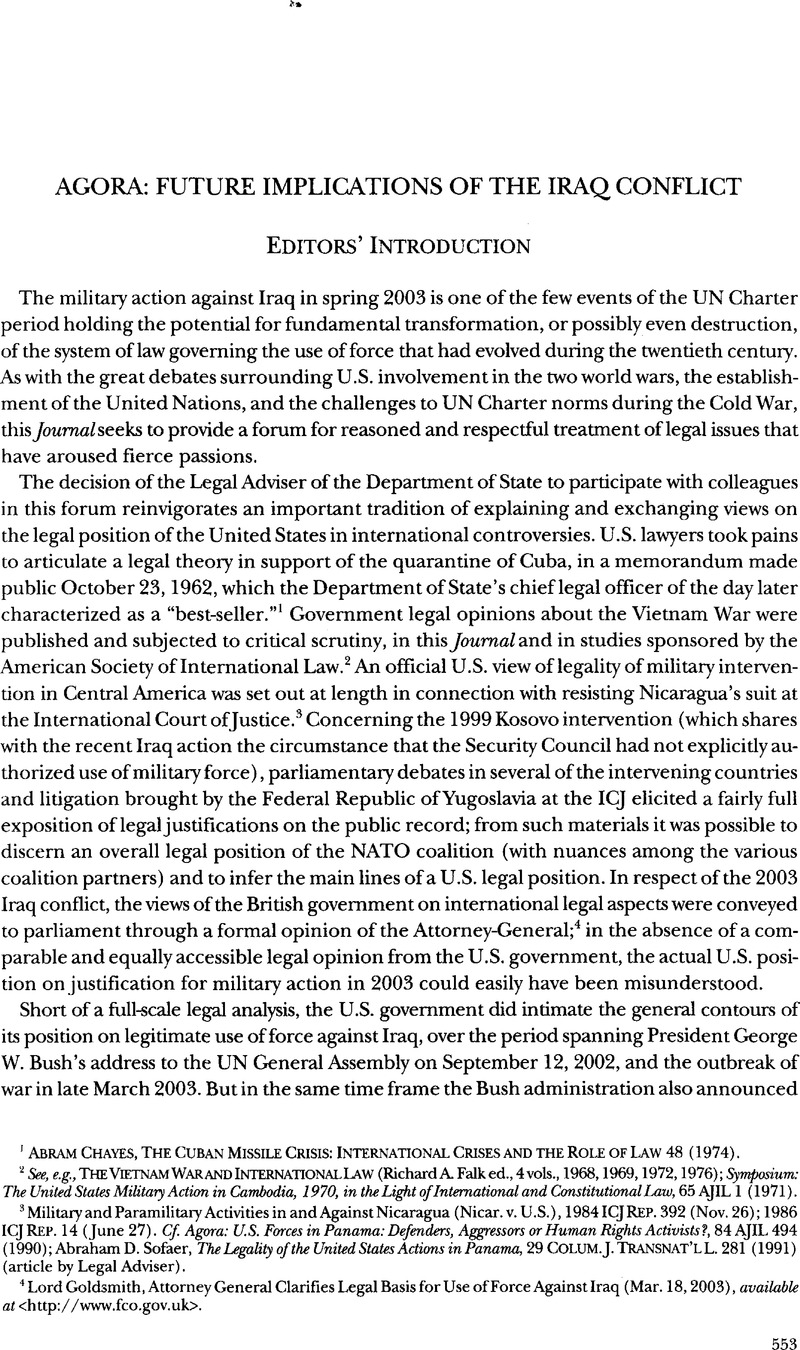Published online by Cambridge University Press: 27 February 2017

1 Abram Chayes, The Cuban Missile Crisis: International Crises and the Role of Law 48 (1974).
2 See, e.g., The Vietnam War and International Law (Falked, Richard A.., 4 vols., 1968, 1969, 1972, 1976)CrossRefGoogle Scholar; Symposium: The United States Military Action in Cambodia, 1970, in the Light of International and Constitutional Law, 65 AJIL 1 (1971).
3 Military and Paramilitary Activities in and Against Nicaragua (Nicar. v. U.S.), 1984 ICJ Rep. 392 (Nov. 26); 1986 ICJ Rep. 14 (June 27). Cf. Agora: U.S. Forces in Panama: Defenders, Aggressors or Human Rights Activists?, 84 AJIL 494 (1990); Sofaer, Abraham D., The Legality of the United States Actions in Panama, 29 Colum. J. Transnat’l L. 281 (1991)Google Scholar (article by Legal Adviser).
4 Lord Goldsmith, Attorney General Clarifies Legal Basis for Use of Force Against Iraq (Mar. 18, 2003), available at <http://www.fco.gov.uk>.
5 The National Security Strategy of the United States of America (Sept. 17, 2002), available at <http://www.whitehouse.gov/nsc/nss.pdf>.
6 Agora: The Gulf Crisis in International and Foreign Relations Law, 85 AJIL 63–109, 506–35 (1991).
7 Lewis, Michael, The Law of Aerial Bombardment in the 1991 Gulf War, 97 AJIL 481 (2003)CrossRefGoogle Scholar.
8 Among them, in the present context we might invite particular attention to Wedgwood, Ruth, The Enforcement of Security Council Resolution 687: The Threat of Force Against Iraq’s Weapons of Mass Destruction, 92 AJIL 724 (1998)CrossRefGoogle Scholar; Lobel, Jules & Ratner, Michael, Bypassing the Security Council: Ambiguous Authorizations to Use Force, Cease-Fires and the Iraqi Inspection Regime, 93 AJIL 124 (1999)CrossRefGoogle Scholar; and Michael Reisman, W., Assessing Claims to Revise the Laws of War, 97 AJIL 82 (2003)CrossRefGoogle Scholar.
9 On developments especially relevant to the legal analysis of the recent conflict, see Sean D. Murphy, Contemporary Practice of the United States Relating to International Law, 96 AJIL 956–62 (2002), 97 AJIL 203–05 (2003), 97 AJIL 419–32 (2003), and 97 AJIL 681–83 (2003) (infra, this issue).
10 See, e.g., Murphy, Sean D., Assessing the Legality of Invading Iraq, 92 GEO. L.J. (forthcoming 2004)Google Scholar.
11 Franck, Thomas M., Who Killed Article 2(4)? or: Changing Norms Governing the Use of Force by States, 64 AJIL 809 (1970)CrossRefGoogle Scholar.